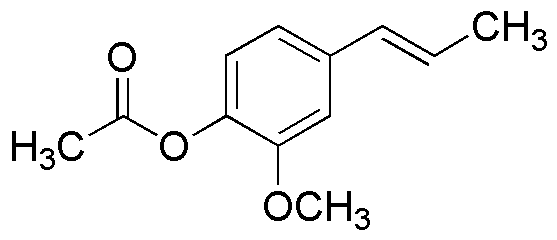Isoeugenyl acetate is widely utilized in research focused on:
- Fragrance Industry: This compound is a key ingredient in perfumes and scented products due to its pleasant aroma, providing a sweet, floral scent that enhances product appeal.
- Flavoring Agent: It is commonly used in the food industry as a flavoring agent, imparting a unique taste to various food products, particularly in baked goods and confectionery.
- Cosmetics: Isoeugenyl acetate is incorporated into cosmetic formulations, where it acts as a fragrance component, contributing to the sensory experience of lotions, creams, and other personal care items.
- Pharmaceuticals: In the pharmaceutical sector, it serves as a potential candidate for developing new therapeutic agents due to its biological activity, particularly in anti-inflammatory and antimicrobial applications.
- Research Applications: Researchers utilize this compound in studies related to organic synthesis and natural product chemistry, exploring its properties and potential derivatives for various applications.
General Information
Properties
Safety and Regulations
Applications
Isoeugenyl acetate is widely utilized in research focused on:
- Fragrance Industry: This compound is a key ingredient in perfumes and scented products due to its pleasant aroma, providing a sweet, floral scent that enhances product appeal.
- Flavoring Agent: It is commonly used in the food industry as a flavoring agent, imparting a unique taste to various food products, particularly in baked goods and confectionery.
- Cosmetics: Isoeugenyl acetate is incorporated into cosmetic formulations, where it acts as a fragrance component, contributing to the sensory experience of lotions, creams, and other personal care items.
- Pharmaceuticals: In the pharmaceutical sector, it serves as a potential candidate for developing new therapeutic agents due to its biological activity, particularly in anti-inflammatory and antimicrobial applications.
- Research Applications: Researchers utilize this compound in studies related to organic synthesis and natural product chemistry, exploring its properties and potential derivatives for various applications.
Documents
Safety Data Sheets (SDS)
The SDS provides comprehensive safety information on handling, storage, and disposal of the product.
Product Specification (PS)
The PS provides a comprehensive breakdown of the product’s properties, including chemical composition, physical state, purity, and storage requirements. It also details acceptable quality ranges and the product's intended applications.
Certificates of Analysis (COA)
Search for Certificates of Analysis (COA) by entering the products Lot Number. Lot and Batch Numbers can be found on a product’s label following the words ‘Lot’ or ‘Batch’.
*Catalog Number
*Lot Number
Certificates Of Origin (COO)
This COO confirms the country where the product was manufactured, and also details the materials and components used in it and whether it is derived from natural, synthetic, or other specific sources. This certificate may be required for customs, trade, and regulatory compliance.
*Catalog Number
*Lot Number
Safety Data Sheets (SDS)
The SDS provides comprehensive safety information on handling, storage, and disposal of the product.
DownloadProduct Specification (PS)
The PS provides a comprehensive breakdown of the product’s properties, including chemical composition, physical state, purity, and storage requirements. It also details acceptable quality ranges and the product's intended applications.
DownloadCertificates of Analysis (COA)
Search for Certificates of Analysis (COA) by entering the products Lot Number. Lot and Batch Numbers can be found on a product’s label following the words ‘Lot’ or ‘Batch’.
*Catalog Number
*Lot Number
Certificates Of Origin (COO)
This COO confirms the country where the product was manufactured, and also details the materials and components used in it and whether it is derived from natural, synthetic, or other specific sources. This certificate may be required for customs, trade, and regulatory compliance.

